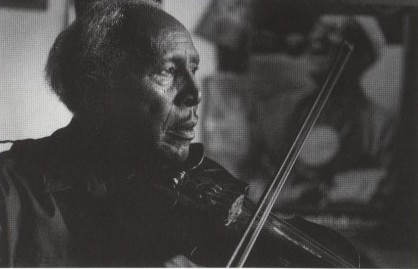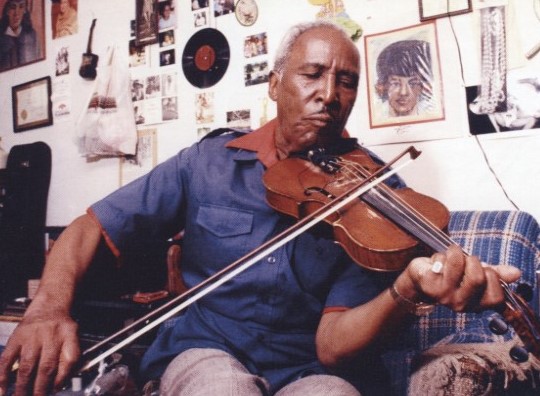Art Form: Blues and string band music
Location(s): Detroit (Wayne County)
Howard "Louie Bluie" Armstrong

Howard Armstrong at his home

Howard Armstrong playing the fiddle

Howard Armstrong playing in his home; photo by Al Kamuda
Howard "Louie Bluie" Armstrong (1910-2003) was a noted practitioner of the over 200-year-old Southern string band musical tradition that influenced the development of ragtime, jazz, and blues music. Southern string bands in the 1920s and 1930s prided themselves on being able to play a wide variety of musical styles, and Howard upheld that tradition with great skill. His extraordinary repertoire seemed endless and diverse beyond description and covered the entire spectrum of American vernacular music, including traditional "southern" style blues, Tin Pan Alley standards, old-time country ditties, folk songs from nineteenth-century Europe, religious hymns, vaudeville, popular songs, jazz, and Appalachian dance tunes.
The son of a Tennessee miner and part-time preacher, Howard grew up listening to the hymns and spirituals his mother played for him and would practice along with them adding his own blues notes. He formed his first string band while still a teenager. With his musical partner Carl Martin, Howard played southern coal camps and medicine shows during the1920s. However, racism in the South prevented groups like Howard's Tennessee Chocolate Drops from participating in string band competitions or recording studio sessions. In the 1930s, Howard, Carl, his brother L.C., and guitarist Ted Bogan formed a new string band called The Four Keys. They moved to Chicago at the end of the decade, mingling with other blues greats of the era, making several recordings, and occasionally traveling into Michigan to play juke joints and restaurants.
After army service in World War II, Howard moved to Detroit and largely stopped performing. In 1972 he reunited with his old bandmates, Carl and Ted. Until Carl's death, the three performed widely in clubs and on the folk festival circuit. Howard and Ted continued to play, performing for the Knoxville World's Fair, the Smithsonian Institution's Festival of American Folklife, the Festival of Michigan Folklife, and on State Department-sponsored Goodwill Tours to Latin America. In 1985, Howard's extraordinary life and musical career were documented in the critically acclaimed film Louie Bluie, the name under which Howard recorded some of his albums.
Howard's mastery of mandolin, guitar, and the relatively rare blues fiddle gave him a distinction among African American string band performers. According to Howard, his successful career in music stemmed from his curiosity in the world: "I always had big eyes and big ears, looking for whatever I could see." (1)
Howard Armstrong also received a National Heritage Fellowship from the National Endowment for the Arts in 1990, the nation's highest honor for folk and traditional artists.
(1) Armstrong, Howard. In Joy Hakanson Colby, "Louie Bluie." The Detroit News. 23 August 1990: 10F.





